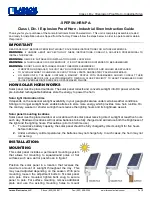
3.2 I/O Terminals
13
IM FG410-01EN
3.2.2 Sync/sub-output (SYNC/SUB OUT)
A sync signal is output according to the waveform or oscillation status. This signal can be
used as the oscilloscope synchronization signal.
As shown in the following table, the output signal can be selected according to the
oscillation mode.
Table 3-1. Signals Selectable for Sync/Sub-Output
■
Output characteristics
Oscillation Mode
Selectable Output Signal
All
50% duty TTL level logic signal that rises at zero phase position of
reference phase of waveform output (hereafter, reference phase sync
signal).
The phase relationship with waveform output can be changed.
Modulation mode with
internal modulation
source
・
Reference phase sync signal
・
Internal modulation signal (
−
3 V to +3 V/open)
・
TTL level logic signal synchronized with internal modulation signal
Sweep oscillation mode
・
Reference phase sync signal
・
Sweep X drive signal (0 V to +3 V/open)
・
TTL level logic signal synchronized with sweep, marker signal mixing
possible
Burst oscillation mode
)
・
Reference phase sync signal
・
TTL level logic signal synchronized with burst oscillation
Sequence oscillation
mode
)
“6.2 Basics” in the
Application Instruction
Manual
・
Reference phase sync signal
・
TTL level logic signal synchronized with sequence step
Output voltage
TTL level (low: 0.4 or lower; high: 2.7 V or higher),
−
3 V to +3 V/open,
0 V to +3 V/open
Output impedance
50
Ω
Load impedance
50
Ω
or higher recommended
Signal GND
Same potential as same channel waveform output, insulated from
housing (42 Vpk max.).
FG420: Insulation also between channels (42 Vpk max.)
CH1
SYNC/SUB
OUT
[Insulated from
housing]
SYNC/SUB
OUT
[Insulated from housing]
CH2
SYNC/SUB
OUT
[Insulated from
housing]
FG420
FG410
















































